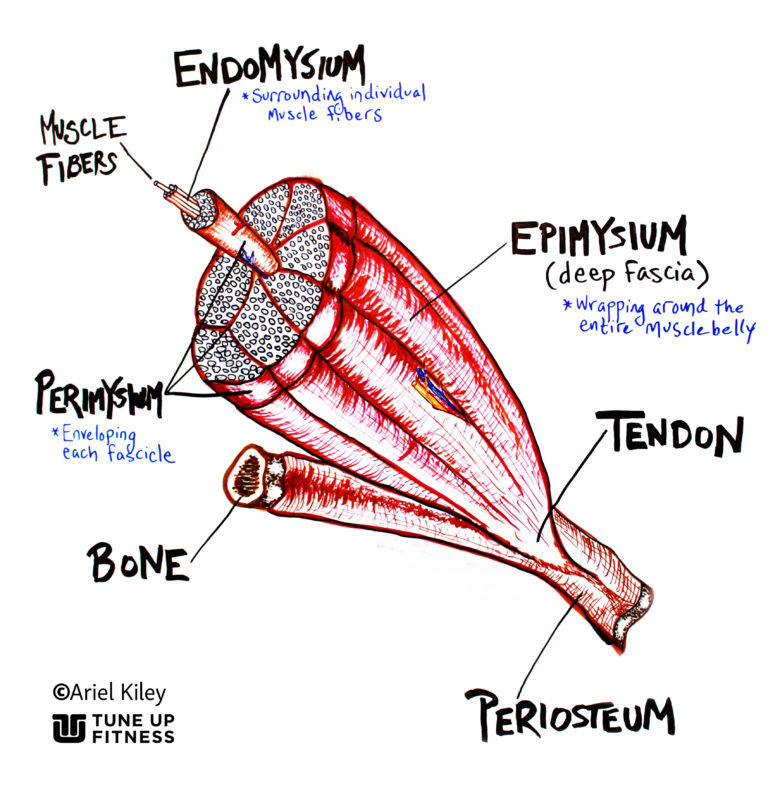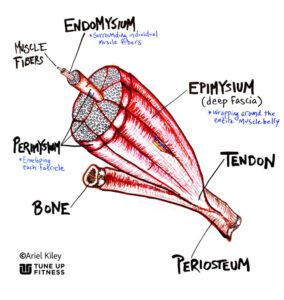
In terms of physical anatomy, we’re all likely very familiar with the skeletal system, circulatory system, immune system, digestive system as well as muscles, tendons, and ligaments.
But, what if I told you that an entire body system (that affects virtually every other system) – has been left off that list?!
The term fascia is from the Latin word meaning “band” or “bandage”, and it is the biological fabric or infrastructure that holds us together.
Essentially, it is our complex network of connective tissue and can be likened to a spider web of fibrous, glue-like proteins that binds all of the other systems together in their proper places.
“Each organ, each muscle, each artery, each vein, each nerve — there is not one single structure in the whole body that is not connected with fascia or not enveloped by fascia.”
– Andreas Haas, Manus Fascia Center, Austria
What is the function of fascia in the body?
Understanding how fascia works is essential to understanding the intrinsic connection between movement and stability in the body as well as the root cause of pain.
Fascia, anatomically – is one network, and all the different names we give elements within it (e.g. tendons and ligaments), can mask the fact that it is, in fact, all one interconnected system.
In fact, fascial connections reach to the very interior of our cells, all the way to the nucleus! How’s that for fascinating body science? (or is it just me who’s fascinated by this stuff?)
Similar to bones, fascia bands are made up of mostly collagen, an important protein building block in the body, which gives them a stretchy texture, but they’re also very tough.
This resilient fascial “fabric”, as I’ve described it, makes up one single biomechanical or anatomical system – and we benefit the most from observing, training, AND treating it that way.
 THE 3 DIFFERENT TYPES OF FASCIA
THE 3 DIFFERENT TYPES OF FASCIA
Superficial, deep, and visceral.
The superficial type is related to the function of the skin, and it’s located…yep, directly under the skin.
Deep fascia refers to the tissue of the bones, nerves, blood vessels, and muscle tissue, while visceral fascia is the tissue protecting and supporting the body’s vital organs.
Its chief overall function in the body is to keep everything in its proper place as well as allowing muscles to move independently – sliding and moving alongside one another.
What does the function of fascia have to do with Structural Integration?
Glad you asked because it’s my specialty!
By nature, fascia is designed to be elastic and move freely with muscles and bones. But stress, effects of aging, injury or work-related repetitive movements can cause it to lose its natural elasticity and become shorter, tighter, and more dense or thickened.
If it is restricted, muscle contraction is also restricted, and tightened fascia pulls our muscles and skeleton out of proper alignment. Consequently, this can cause pain, discomfort, and postural changes.
Studies show that fascial tension in one structure, such as the knee – can cause referred pain, excessive tension or misalignment in neighboring structures, such as the hip or ankle.
Common conditions you’ve likely heard of like Plantar Fasciitis, IT Band Syndrome, Sciatica, Shin Splints, Tennis Elbow, and Frozen Shoulder – are all attributed to distortions in your fascia.
Structural Integration works to lengthen, stretch, and soften this overly restricted tissue to restore postural balance, ease of movement, and a feeling of being more “at home” within your own body.
Umm, but what does fascia have to do with MY CELLULITE?!
Believe it or not, even those cute little dimples on your backside, that most of us call “cellulite” — are also due to unhealthy fascia!
Many people think cellulite is a type of fat tissue, but it’s actually caused by the same kind of distortions in your connective tissue as the other conditions I’ve mentioned.
So again, when the fascia is adhesed or stuck together, it can draw the skin inward and, as fat tissue in that particular area (like your backside!) pushes through the gummed up fascia, it creates the telltale puckered look of cellulite.
While you might not be too thrilled to have learned this cool new fact about your body’s quirky tendencies, it has to be comforting to know that you can harness your newfound knowledge about fascia 🙂
Get (un)knotty with Myofascial Release or “stretch therapy”
Tight fascia is every bit as painful and sometimes debilitating as a tight muscle.
This is the main objective of myo- (muscle) fascial (connective tissue) release — to restore the natural elasticity to overly tight fascia.

Releasing these adhesions is like detangling a bunch of sailor’s knots between the muscles, allowing them to glide more freely – which in turn increases hydration and allows toxins to be flushed out more easily.
Additionally, because our fascia is heavily innervated, “detangling” these tissues clears the nerve signal pathways to the brain, aiding in muscle coordination, and an increased ability to control movements and body awareness or ‘proprioception’ – the geek term I like to use!
MYOFASCIAL RELEASE also increases range of motion and reduces pain and recovery time.
Restoring your fascia back to a healthier state of function
Healthy fascia relies on hydration and specific movement patterns, so targeted techniques that facilitate this can be used to manipulate the muscles and surrounding tissues.
Because fascia is 3-dimensional (running not just around the muscles but also through it), basic stretching routines are simply not able to navigate through your muscle to zoom in on tight fascia the way a therapist’s elbow can! *hint, hint*
By using a number of pinpointed release techniques in my practice, together we can help stimulate the fascial repair process to free up the restricted tissues, and effectively increase their range of motion – both during and after our sessions.
Massage, myofascial release and foam rolling (or other forms of self-release like massage balls) are some of the most common ways to target this often neglected tissue system.
However, now that you’re so much more aware of your body’s unsung anatomical hero – you can be sure to take the necessary steps and give it the proper attention it deserves.
“I know of no part of the body that equals the fascia as a hunting ground. All nerves go to and terminate in that great system, the fascia. By its action, we live and by its failure, we die. The soul of man, with all the streams of pure living water, seems to dwell in the fascia of his body.” – A.T. Still, the founder of Osteopathy
Now go forth and make your fascia happy today!
Think YOU might have a case of unhappy fascia?
REFERENCES:
Journal of Bodywork and Movement Therapies (Jan 2017) – Defining The Fascial System
Washington Post – Fascia: Scientists Are Unlocking Its Secrets
Tune Up Fitness – Understanding Fascia and the Benefits of Myofascial Release
Fascia Research Congress – Intermuscular force transmission along myofascial chains. A systematic review (2015).